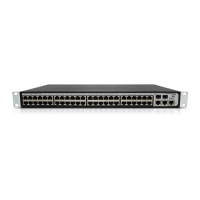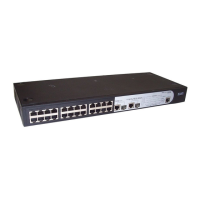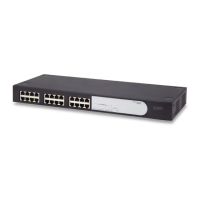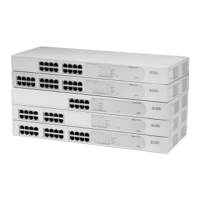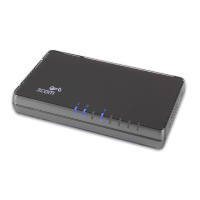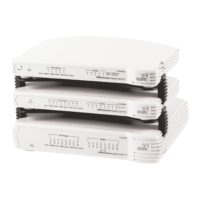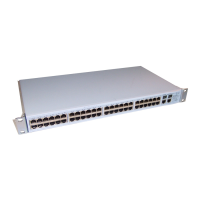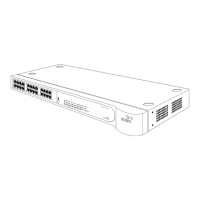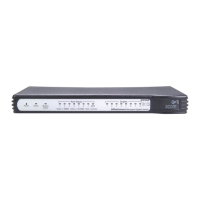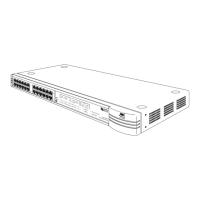Do you have a question about the 3Com 3CBLSG48 and is the answer not in the manual?
Provides an overview of the User Guide's sections and content, detailing what each section covers.
Displays general device information, including system name, MAC address, software, and hardware versions from the Device Summary page.
Provides information about the RJ45 or SFP port status colors and their meanings as defined in the Color Key Page.
Allows network administrators to define users, passwords, and access levels for switch management via the System Access Interface.
Displays current users and their access levels defined on the device via the System Access Summary Page.
Enables network administrators to define new users, passwords, and access levels via the System Access Setup Page.
Guides users on modifying existing configuration information, such as user access levels and passwords, through the System Access Modify Page.
Explains how to remove user accounts and their associated settings from the switch using the System Access Remove Page.
Details configuring RADIUS client settings, including server IP addresses and authentication parameters, for network security.
Explains port-based authentication, which authenticates users on a per-port basis via an external server using EAP.
Allows viewing port-based authentication settings, including port control and reauthentication periods, through the 802.1X Summary Page.
Provides information for configuring 802.1X global settings and port-specific settings, including authentication methods and guest VLANs.
Allows network managers to define classification actions and rules for specific ingress ports using Access Control Lists (ACL) to control traffic.
Displays information regarding MAC-based ACLs configured on the device via the MAC Based ACL Summary Page, showing rules and actions.
Allows selection, creation, and definition of rules for MAC-based Access Control Lists, specifying source/destination MAC addresses and actions.
Guides on modifying MAC Based ACL settings, including priorities and rules, through the MAC Based ACL Modify Page.
Explains how to remove MAC Based ACLs from the device using the MAC Based ACL Remove Page by selecting ACL names.
Displays information regarding IP-based ACLs configured on the device via the IP Based ACL Summary Page, showing rules and actions.
Allows configuration of IP-based Access Control Lists by defining rules based on protocols, IP addresses, and TCP flags.
Guides on modifying IP Based ACL settings, including priorities, protocols, and IP addresses, through the IP Based ACL Modify Page.
Explains how to remove IP Based ACLs from the device using the IP Based ACL Remove Page by selecting ACL names and applying the change.
Displays user-defined ACLs mapped to the interfaces via the ACL Binding Summary Page, showing which ACL is bound to which port.
Allows administrators to bind specific ports to MAC or IP Based ACLs using the ACL Binding Setup Page, defining port-ACL associations.
Explains how to remove user-defined ACLs from a selected interface using the ACL Binding Remove Page by selecting the ACL and interface.
Explains how Broadcast Storm limits multicast and broadcast frames to prevent network congestion by discarding frames exceeding a defined rate.
Details modifying Broadcast Storm settings, including broadcast mode and rate thresholds, for selected ports via the Broadcast Storm Modify Page.
Explains VLANs as logical subgroups for network traffic management, isolation, and segmentation on a LAN, and the role of VLAN1.
Displays port usage by linking groups of ports to form a single LAG via the Link Aggregation Summary Page, showing group ID and member ports.
Details creating a Link Aggregated Group (LAG) to optimize port usage, increase bandwidth, and provide link redundancy.
Guides on modifying existing Link Aggregated Groups (LAGs), adding or removing ports, via the Link Aggregation Modify Page.
Explains how to remove group IDs containing member ports from Link Aggregation using the Link Aggregation Remove Page.
Displays fields for viewing LACP LAGs, including port status, priority, and state, via the LACP Summary Page.
Guides on configuring the system priority for LACP setup via the LACP Setup Page to influence port choice in link aggregation.
Details configuring LACP port settings, including status and priority, via the LACP Port Setup Page for link aggregation management.
Provides information and global parameters on VLANs configured on the system, including membership types, via the VLAN Detail Page.
Displays VLAN configured ports and their details, such as untagged or tagged membership, via the VLAN Port Detail Page.
Guides administrators in creating user-defined VLANs by specifying VLAN IDs and names using the VLAN Setup Page.
Allows administrators to rename user-defined VLAN names via the VLAN Rename Page by selecting a VLAN and entering a new name.
Guides network managers in changing VLAN membership for ports, selecting membership types and ports, using the Modify VLAN Page.
Details modifying port VLAN settings, including membership type and VLAN ID assignment, via the Modify VLAN Port Page.
Explains how administrators can remove VLANs from the device using the VLAN Remove Page by selecting VLAN IDs and confirming removal.
Details assigning IP addresses, subnet masks, and default gateways for network interfaces on the switch.
Displays current ARP settings, including interface, IP address, MAC address, and status, via the ARP Settings Summary Page.
Allows managers to define ARP parameters for specific interfaces using the ARP Settings Setup Page.
Explains how to remove ARP entries from the ARP Table using the ARP Settings Remove Page by selecting entry types.
Discusses MAC addresses stored in static or dynamic address databases and their management, including learning and aging.
Displays the current MAC address table configuration via the Address Table Summary Page, filtering by state and other parameters.
Allows users to view MAC addresses assigned to specific ports via the Port Summary Page, showing MAC address, VLAN ID, and state.
Guides managers in assigning MAC addresses to ports with VLANs using the Address Table Add Page, specifying VLAN ID, MAC, and port.
Allows managers to define the Address Table Aging Time for dynamic MAC addresses, specifying the time before addresses are timed out.
Explains how to remove ports from the address tables using the Port Remove Page by selecting ports and MAC addresses to delete.
Guides on removing current MAC addresses from the Address Table using the Address Table Remove Page by selecting MAC addresses.
Introduces IGMP Snooping and Query configuration for managing multicast traffic forwarding and queries on the device.
Details configuring IGMP Snooping and Query parameters, including device and VLAN status, via the IGMP Snooping & Query Setup Page.
Displays current Spanning Tree parameters for all ports, including status, path cost, and edge port settings, via the Spanning Tree Summary Page.
Guides administrators in assigning STP settings to specific interfaces, including STP version and priority, using the Spanning Tree Setup Page.
Details how to modify Spanning Tree parameters for ports, such as status and edge port settings, via the Spanning Tree Port Setup Page.
Describes the support for SNMP versions 1 and 2c for network device management and monitoring.
Allows management of access rights by defining communities in the SNMP Communities Setup Page, specifying management stations and access modes.
Explains how to remove SNMP communities using the SNMP Communities Remove Page by selecting communities to remove.
Details defining filters for sending traps to specific users and specifying trap types (SNMP V1/V2c) via the SNMP Traps Setup Page.
Guides on removing SNMP traps using the SNMP Traps Remove Page by selecting recipients to delete.
Displays Class of Service (CoS) default settings assigned to ports on the device via the CoS Summary Page, showing interface and default CoS values.
Provides information for enabling QoS globally on the device using the CoS Setup Page, allowing selection of ports and default user priority.
Details configuring queue scheduling methods, such as strict priority and WRR, for traffic management based on assigned weights.
Displays a table mapping CoS values to traffic queues via the CoS to Queue Summary Page, showing Class of Service and corresponding Queue assignments.
Guides on mapping CoS values to traffic queues using the CoS to Queue Setup Page by defining the queue number for each CoS value.
Displays fields for mapping DSCP settings to traffic queues via the DSCP to CoS Summary Page, showing incoming DSCP values and their CoS mapping.
Guides on mapping DSCP settings to CoS values using the DSCP to CoS Setup Page by defining the CoS field for required DSCP values.
Details enabling trust on configured interfaces by defining which packet fields (CoS or DSCP) to use for classifying traffic.
Displays bandwidth settings for a specified interface via the Bandwidth Summary Page, including ingress rate limit and egress shaping rates.
Guides network managers in defining bandwidth settings for a specified interface, including rate limits and shaping types, using the Bandwidth Setup Page.
Allows administrators to enhance VoIP service by configuring ports for IP voice traffic on a specific VLAN, supporting tagged packets.
Displays information about the Voice VLAN currently enabled on the device, including enabled ports, via the Voice VLAN Summary Page.
Provides information for enabling and defining Voice VLAN globally on the device using the Voice VLAN Setup Page, managing voice traffic.
Details configuring Voice VLAN port settings, including mode and security, via the Voice VLAN Port Setup Page for specific ports.
Displays Voice VLAN port settings for specific ports, including mode and security, via the Voice VLAN Port Details Page.
Lists Organizationally Unique Identifiers (OUIs) associated with the Voice VLAN, showing default OUIs for IP phones.
Allows administrators to add new OUIs or remove previously defined OUIs from the Voice VLAN using the Voice VLAN OUI Modify Page.
Outlines the structure of configuration files, including startup and running configurations, and image files for system management.
Guides network managers in backing up the system configuration to a TFTP or HTTP server using the Backup Page.
Details restoring files from a TFTP or HTTP server to the device using the Restore Page.
Allows network managers to upgrade the switch firmware using the Restore Image Page, specifying the TFTP server and file name.
Guides managers in selecting and resetting image files to activate the desired firmware version using the Active Image Page.
Provides fields for viewing information about device utilization and errors that occurred on network ports via the Port Statistics Summary Page.
Details configuring port mirroring by selecting specific ports to copy packets to a monitoring port for diagnostics.
Explains how to terminate port mirroring or monitoring using the Port Mirroring Remove Page by selecting ports to be removed.
Displays fields for viewing tests on copper cables, including test results, cable fault distance, and last update time.
Describes 3Com Network Supervisor (3NS) as an application for discovering, mapping, and monitoring network devices and links.
Details 3Com Network Director (3ND) for managing and administering midsized networks, including discovery, mapping, and configuration tasks.
Describes the 3Com Enterprise Management Suite (EMS) for comprehensive and scalable network management, including configuration and change control.
Lists the standards the 3Com Baseline Switch 2948-SFP Plus has been designed to comply with for functionality, safety, and emissions.
Describes device features supported by the system, including Auto-Negotiation, Back Pressure, and Address Resolution Protocol (ARP).
Details the pin-out configuration of the 8-conductor RJ45-to-DB9 console cable used for connecting to the switch's console port.
Provides pin assignments for Null Modem Cable connections (RJ45 to RS-232) for serial communication.
Lists pin assignments for 10/100 and 1000BASE-T RJ-45 Ethernet connections for MDI and MDIX ports.
Provides information about isolating problems, quantifying them, and applying solutions for device issues by identifying causes and effects.
Lists common troubleshooting problems and their corresponding possible causes and solutions for the switch, covering connection and status issues.
Describes using the Command Line Interface (CLI) to manage the device by entering configuration commands and parameters, similar to UNIX.
Lists common CLI commands available on the device for configuration and management, including initialize, ipSetup, ping, and reboot.
Explains the Ping command used to send ICMP echo request packets to another node on the network to test connectivity.
Details the ipSetup command for defining an IP address on the device manually or via DHCP, specifying IP address, subnet mask, and gateway.
Explains the Upgrade command for starting a system download to perform a system upgrade, specifying TFTP server and source file name.
Describes the Initialize command to reset the device configuration to factory defaults, excluding IP configuration, and causing a reset.
Defines ACEs as filters that determine traffic classifications for Access Control Lists (ACLs).
Details port authentication controlling access to switch ports by requiring user ID and password for verification.
Defines LAG as aggregating ports or VLANs into a single virtual port or VLAN for increased bandwidth and link redundancy.
Defines VLAN as a collection of network nodes sharing a collision domain, forming a logical workgroup for traffic segmentation.
Encourages product registration for warranty and service benefits via eSupport.3com.com, requiring a user name and password.
Provides information on accessing bug fix and maintenance releases for the purchased software version, requiring product registration and serial number.
States compliance with FCC limits for Class A digital devices and provides guidelines for correcting radio frequency interference.
Provides an overview of the User Guide's sections and content, detailing what each section covers.
Displays general device information, including system name, MAC address, software, and hardware versions from the Device Summary page.
Provides information about the RJ45 or SFP port status colors and their meanings as defined in the Color Key Page.
Allows network administrators to define users, passwords, and access levels for switch management via the System Access Interface.
Displays current users and their access levels defined on the device via the System Access Summary Page.
Enables network administrators to define new users, passwords, and access levels via the System Access Setup Page.
Guides users on modifying existing configuration information, such as user access levels and passwords, through the System Access Modify Page.
Explains how to remove user accounts and their associated settings from the switch using the System Access Remove Page.
Details configuring RADIUS client settings, including server IP addresses and authentication parameters, for network security.
Explains port-based authentication, which authenticates users on a per-port basis via an external server using EAP.
Allows viewing port-based authentication settings, including port control and reauthentication periods, through the 802.1X Summary Page.
Provides information for configuring 802.1X global settings and port-specific settings, including authentication methods and guest VLANs.
Allows network managers to define classification actions and rules for specific ingress ports using Access Control Lists (ACL) to control traffic.
Displays information regarding MAC-based ACLs configured on the device via the MAC Based ACL Summary Page, showing rules and actions.
Allows selection, creation, and definition of rules for MAC-based Access Control Lists, specifying source/destination MAC addresses and actions.
Guides on modifying MAC Based ACL settings, including priorities and rules, through the MAC Based ACL Modify Page.
Explains how to remove MAC Based ACLs from the device using the MAC Based ACL Remove Page by selecting ACL names.
Displays information regarding IP-based ACLs configured on the device via the IP Based ACL Summary Page, showing rules and actions.
Allows configuration of IP-based Access Control Lists by defining rules based on protocols, IP addresses, and TCP flags.
Guides on modifying IP Based ACL settings, including priorities, protocols, and IP addresses, through the IP Based ACL Modify Page.
Explains how to remove IP Based ACLs from the device using the IP Based ACL Remove Page by selecting ACL names and applying the change.
Displays user-defined ACLs mapped to the interfaces via the ACL Binding Summary Page, showing which ACL is bound to which port.
Allows administrators to bind specific ports to MAC or IP Based ACLs using the ACL Binding Setup Page, defining port-ACL associations.
Explains how to remove user-defined ACLs from a selected interface using the ACL Binding Remove Page by selecting the ACL and interface.
Explains how Broadcast Storm limits multicast and broadcast frames to prevent network congestion by discarding frames exceeding a defined rate.
Details modifying Broadcast Storm settings, including broadcast mode and rate thresholds, for selected ports via the Broadcast Storm Modify Page.
Explains VLANs as logical subgroups for network traffic management, isolation, and segmentation on a LAN, and the role of VLAN1.
Displays port usage by linking groups of ports to form a single LAG via the Link Aggregation Summary Page, showing group ID and member ports.
Details creating a Link Aggregated Group (LAG) to optimize port usage, increase bandwidth, and provide link redundancy.
Guides on modifying existing Link Aggregated Groups (LAGs), adding or removing ports, via the Link Aggregation Modify Page.
Explains how to remove group IDs containing member ports from Link Aggregation using the Link Aggregation Remove Page.
Displays fields for viewing LACP LAGs, including port status, priority, and state, via the LACP Summary Page.
Guides on configuring the system priority for LACP setup via the LACP Setup Page to influence port choice in link aggregation.
Details configuring LACP port settings, including status and priority, via the LACP Port Setup Page for link aggregation management.
Provides information and global parameters on VLANs configured on the system, including membership types, via the VLAN Detail Page.
Displays VLAN configured ports and their details, such as untagged or tagged membership, via the VLAN Port Detail Page.
Guides administrators in creating user-defined VLANs by specifying VLAN IDs and names using the VLAN Setup Page.
Allows administrators to rename user-defined VLAN names via the VLAN Rename Page by selecting a VLAN and entering a new name.
Guides network managers in changing VLAN membership for ports, selecting membership types and ports, using the Modify VLAN Page.
Details modifying port VLAN settings, including membership type and VLAN ID assignment, via the Modify VLAN Port Page.
Explains how administrators can remove VLANs from the device using the VLAN Remove Page by selecting VLAN IDs and confirming removal.
Details assigning IP addresses, subnet masks, and default gateways for network interfaces on the switch.
Displays current ARP settings, including interface, IP address, MAC address, and status, via the ARP Settings Summary Page.
Allows managers to define ARP parameters for specific interfaces using the ARP Settings Setup Page.
Explains how to remove ARP entries from the ARP Table using the ARP Settings Remove Page by selecting entry types.
Discusses MAC addresses stored in static or dynamic address databases and their management, including learning and aging.
Displays the current MAC address table configuration via the Address Table Summary Page, filtering by state and other parameters.
Allows users to view MAC addresses assigned to specific ports via the Port Summary Page, showing MAC address, VLAN ID, and state.
Guides managers in assigning MAC addresses to ports with VLANs using the Address Table Add Page, specifying VLAN ID, MAC, and port.
Allows managers to define the Address Table Aging Time for dynamic MAC addresses, specifying the time before addresses are timed out.
Explains how to remove ports from the address tables using the Port Remove Page by selecting ports and MAC addresses to delete.
Guides on removing current MAC addresses from the Address Table using the Address Table Remove Page by selecting MAC addresses.
Introduces IGMP Snooping and Query configuration for managing multicast traffic forwarding and queries on the device.
Details configuring IGMP Snooping and Query parameters, including device and VLAN status, via the IGMP Snooping & Query Setup Page.
Displays current Spanning Tree parameters for all ports, including status, path cost, and edge port settings, via the Spanning Tree Summary Page.
Guides administrators in assigning STP settings to specific interfaces, including STP version and priority, using the Spanning Tree Setup Page.
Details how to modify Spanning Tree parameters for ports, such as status and edge port settings, via the Spanning Tree Port Setup Page.
Describes the support for SNMP versions 1 and 2c for network device management and monitoring.
Allows management of access rights by defining communities in the SNMP Communities Setup Page, specifying management stations and access modes.
Explains how to remove SNMP communities using the SNMP Communities Remove Page by selecting communities to remove.
Details defining filters for sending traps to specific users and specifying trap types (SNMP V1/V2c) via the SNMP Traps Setup Page.
Guides on removing SNMP traps using the SNMP Traps Remove Page by selecting recipients to delete.
Displays Class of Service (CoS) default settings assigned to ports on the device via the CoS Summary Page, showing interface and default CoS values.
Provides information for enabling QoS globally on the device using the CoS Setup Page, allowing selection of ports and default user priority.
Details configuring queue scheduling methods, such as strict priority and WRR, for traffic management based on assigned weights.
Displays a table mapping CoS values to traffic queues via the CoS to Queue Summary Page, showing Class of Service and corresponding Queue assignments.
Guides on mapping CoS values to traffic queues using the CoS to Queue Setup Page by defining the queue number for each CoS value.
Displays fields for mapping DSCP settings to traffic queues via the DSCP to CoS Summary Page, showing incoming DSCP values and their CoS mapping.
Guides on mapping DSCP settings to CoS values using the DSCP to CoS Setup Page by defining the CoS field for required DSCP values.
Details enabling trust on configured interfaces by defining which packet fields (CoS or DSCP) to use for classifying traffic.
Displays bandwidth settings for a specified interface via the Bandwidth Summary Page, including ingress rate limit and egress shaping rates.
Guides network managers in defining bandwidth settings for a specified interface, including rate limits and shaping types, using the Bandwidth Setup Page.
Allows administrators to enhance VoIP service by configuring ports for IP voice traffic on a specific VLAN, supporting tagged packets.
Displays information about the Voice VLAN currently enabled on the device, including enabled ports, via the Voice VLAN Summary Page.
Provides information for enabling and defining Voice VLAN globally on the device using the Voice VLAN Setup Page, managing voice traffic.
Details configuring Voice VLAN port settings, including mode and security, via the Voice VLAN Port Setup Page for specific ports.
Displays Voice VLAN port settings for specific ports, including mode and security, via the Voice VLAN Port Details Page.
Lists Organizationally Unique Identifiers (OUIs) associated with the Voice VLAN, showing default OUIs for IP phones.
Allows administrators to add new OUIs or remove previously defined OUIs from the Voice VLAN using the Voice VLAN OUI Modify Page.
Outlines the structure of configuration files, including startup and running configurations, and image files for system management.
Guides network managers in backing up the system configuration to a TFTP or HTTP server using the Backup Page.
Details restoring files from a TFTP or HTTP server to the device using the Restore Page.
Allows network managers to upgrade the switch firmware using the Restore Image Page, specifying the TFTP server and file name.
Guides managers in selecting and resetting image files to activate the desired firmware version using the Active Image Page.
Provides fields for viewing information about device utilization and errors that occurred on network ports via the Port Statistics Summary Page.
Details configuring port mirroring by selecting specific ports to copy packets to a monitoring port for diagnostics.
Explains how to terminate port mirroring or monitoring using the Port Mirroring Remove Page by selecting ports to be removed.
Displays fields for viewing tests on copper cables, including test results, cable fault distance, and last update time.
Describes 3Com Network Supervisor (3NS) as an application for discovering, mapping, and monitoring network devices and links.
Details 3Com Network Director (3ND) for managing and administering midsized networks, including discovery, mapping, and configuration tasks.
Describes the 3Com Enterprise Management Suite (EMS) for comprehensive and scalable network management, including configuration and change control.
Lists the standards the 3Com Baseline Switch 2948-SFP Plus has been designed to comply with for functionality, safety, and emissions.
Describes device features supported by the system, including Auto-Negotiation, Back Pressure, and Address Resolution Protocol (ARP).
Details the pin-out configuration of the 8-conductor RJ45-to-DB9 console cable used for connecting to the switch's console port.
Provides pin assignments for Null Modem Cable connections (RJ45 to RS-232) for serial communication.
Lists pin assignments for 10/100 and 1000BASE-T RJ-45 Ethernet connections for MDI and MDIX ports.
Provides information about isolating problems, quantifying them, and applying solutions for device issues by identifying causes and effects.
Lists common troubleshooting problems and their corresponding possible causes and solutions for the switch, covering connection and status issues.
Describes using the Command Line Interface (CLI) to manage the device by entering configuration commands and parameters, similar to UNIX.
Lists common CLI commands available on the device for configuration and management, including initialize, ipSetup, ping, and reboot.
Explains the Ping command used to send ICMP echo request packets to another node on the network to test connectivity.
Details the ipSetup command for defining an IP address on the device manually or via DHCP, specifying IP address, subnet mask, and gateway.
Explains the Upgrade command for starting a system download to perform a system upgrade, specifying TFTP server and source file name.
Describes the Initialize command to reset the device configuration to factory defaults, excluding IP configuration, and causing a reset.
Defines ACEs as filters that determine traffic classifications for Access Control Lists (ACLs).
Details port authentication controlling access to switch ports by requiring user ID and password for verification.
Defines LAG as aggregating ports or VLANs into a single virtual port or VLAN for increased bandwidth and link redundancy.
Defines VLAN as a collection of network nodes sharing a collision domain, forming a logical workgroup for traffic segmentation.
Encourages product registration for warranty and service benefits via eSupport.3com.com, requiring a user name and password.
Provides information on accessing bug fix and maintenance releases for the purchased software version, requiring product registration and serial number.
States compliance with FCC limits for Class A digital devices and provides guidelines for correcting radio frequency interference.
| Product Type | Switch |
|---|---|
| Number of Ports | 48 |
| Layer | Layer 2 |
| Rack Mountable | Yes |
| Manageable | Yes |
| Form Factor | Rack-mountable |
| Power Supply | Internal |
| Port Type | Gigabit Ethernet |
| MAC Address Table | 8000 entries |
| Ports | 48 x 10/100/1000 |
